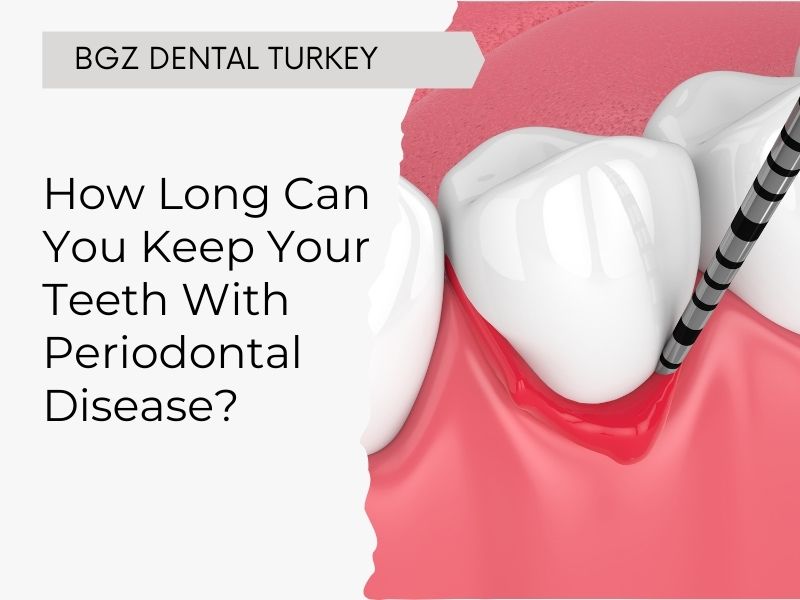
What is periodontal disease?
Periodontal disease, also known as gum disease, is a condition damaging your gums and jaw bone. Bacteria contained in teeth plaque teeth cause symptoms including bleeding gums, pain, and tooth loss.
If untreated, this disease can progress from mild inflammation (gingivitis) to severe infection (periodontitis). In last stages your teeth can loose. Early treatment and good oral hygiene can prevent or manage its harmful effects.
Nearly half of UK adults are thought to have some degree of periodontal disease. It means we can say for it, it is one of the most common long-term inflammatory conditions. While it’s most common in people aged 60-64, it can actually affect anyone, no matter their age.
Causes of gum disease
Periodental disease doesn’t just happen overnight. Many factors cause it. We can control some of the factors like oral hygiene or smoking. Other factors are out of our hands like genetics or hormonal changes. Understanding the main causes help you stay ahead of the problem and keep your gums healthy. We are giving common reasons for the gum disease below.
- Poor hygiene: Plaque and tartar irritate gums.
- Smoking: Damages gums and slows healing.
- Diabetes: Raises infection risk in gums.
- Genetics: Some are more prone to gum issues.
- Hormones: Pregnancy and menopause affect gums.
- Stress: Weakens gum defense.
- Poor diet: Lack of nutrients harms gums.
- Medications: Dry out gums and reduce protection.
- Teeth grinding: Puts pressure on gums.
- Dry mouth: Leads to gum irritation.
- Crooked teeth: Harder to clean, causing plaque.
- Mouth breathing: Dries gums and makes them vulnerable
Stages of periodontal disease
Gingivitis
When you start seeing red swollen gums that bleed during tooth brushing you have entered the initial stage of gum disease. You can treat gum disease early when you remove plaque buildup through proper dental care.
Early periodontitis
When gingivitis remains untreated the condition becomes more serious. The infection moves into your gum line and creates small pockets while starting to damage your bone structure. Although your teeth feel secure the gum tissue is weakening.
Moderate periodontitis
The harm to your teeth becomes more visible at this phase. Your teeth loosen up as your gums move backward into deeper spaces and you develop persistent unpleasant breath. You may detect minor tooth movement and light wobbliness in your teeth.
Advanced periodontitis
This is the serious stage. The bone and tissue that support your teeth weaken significantly and your teeth become so loose they may drop out. The condition impacts both your teeth and your entire body making it a severe medical problem.
How is periodontal disease treated?
|
Stage |
Treatment options |
|
Gingivitis (Early stage) |
Professional teeth whitening to remove plaque and tartar on teeth around the gums. |
|
Brushing your teeth twice a day is essential. This keep gums healthy. |
|
|
Flossing daily to remove food particles and plaque between your teeth. |
|
|
Using an antibacterial mouthwash is good and right way. |
|
|
Regular dental checkups to catch problem early. |
|
|
Periodontitis (Moderate stage) |
Deep cleaning, called scaling and root planing, to remove tartar from below the gumline and smooth the tooth roots. |
|
Medicated antibiotic gels or mouth rinses, to control infection and heal the gums. |
|
|
Performing home care! Proper brushing and flossing |
|
|
Regular follow-up appointments to monitor gum health and prevent further damage. |
|
|
Advanced periodontitis (Severe stage) |
Pocket reduction surgery to clean bacteria from deep pockets and reshape gums to fit tightly around teeth. |
|
Gum graft surgery to restore lost gum tissue and protect tooth roots from further damage. |
|
|
Bone grafts to rebuild bone that was destroyed by the infection and provide support for teeth. |
|
|
Guided tissue regeneration to help new bone and tissue grow in areas damaged by periodontitis. |
|
|
In extreme cases, tooth extraction to stop the infection from spreading and prepare for replacement options like implants. |
Non-surgical periodontal treatments
Scaling and root planning (SRP)
Dentists use this cleaning method to scrape off plaque and tartar below your gums while making the root surfaces more even. SRP works well to reduce swelling and stop gum disease development, as the According to the American Academy of Periodontology reports JADA
Antibiotic therapy
Local or systemic antibiotics may be used to eliminate bacteria causing the infection. The Journal of Clinical Periodontology's studies show that placing doxycycline gel directly onto the affected areas helps periodontal treatment work better. JADA
Laser therapy
Dentists may employ also lasers to clean out gum inflammation and wipe out bacteria hiding in periodontal pockets. The American Dental Association backs the use of laser treatment together with SRP to help people heal faster. JOURNAL OF CLİNİCAL PERIODENTOLOGY
Perio tray delivery systems
A special tray puts medicine right where it's needed, into the gum pockets. The Food and Drug Administration (FDA) approved Perio Protect to help deliver medication directly to gum areas where bacteria grow. The U.S. FDA cleared the Perio Protect Tray for marketing on January 23, 2004, under the 510(k) premarket notification process, determining it to be substantially equivalent to a previously marketed disposable fluoride tray. FDA ACCESS DATA
Ongoing maintenance therapy
After finishing treatment, patients need to have deep cleanings every 3-4 months to maintain their gum health, instead of regular cleanings like before. Studies published in the Journal of Dental Research show that regular maintenance treatments greatly reduce the chance of gum disease returning.
Traditional surgical treatments for advanced periodontitis
Flap surgery (Pocket reduction surgery)
A flap surgery is a procedure that lifts the gums to clean out bacteria and tartar from deep pockets between the gums and teeth.
The procedure lifts your gums so we can clean out the hard tartar and bacteria hiding in the deepest pockets. The doctor puts the gums back together after lifting them, which shrinks the pockets and helps you brush and floss more easily. Research published in the Journal of Periodontology shows that flap surgery works well to clean out periodontal pockets and keep gums healthier over time.
Bone grafting
If periodontitis takes away bone from around your teeth, doctors can put bone grafts back to fill in the empty spaces. Doctors use three types of grafts: they may take tissue from the patient's own body (autograft), from a donor (allograft), or from synthetic materials. Bone grafts trigger your body's natural ability to rebuild bones while holding your teeth firmly in place. A study in Clinical Advances in Periodontics shows how well it restores lost bone in severe cases.
GTR method
Placing a special barrier between the gum and bone helps the body recover lost bone and gum tissue. This technique is often combined with bone grafts for better results. Research finds that GTR helps rebuild bone better than regular treatments alone.
Soft tissue grafts
When gum disease pulls back your gums, soft tissue grafting helps cover and protect your tooth roots. Dentists take tissue from the roof of your mouth and place it on the problem area. The method makes gums healthier, guards the tooth's root, and makes teeth look better.
Osseous surgery
This procedure fixes and makes better the bone that has been damaged by periodontitis. Doctors cut out bad bone and reshape what's left to stop bacteria from building up and make cleaning the area much simpler.
How long can you keep your teeth with periodontal disease?
How long you can keep your teeth with periodontal disease depends on how early it’s diagnosed and how well it’s treated. Advanced periodontal disease leads to multiple tooth loss if you do not receive treatment. You need continuous medical treatment because this disease stays with you permanently. When you do not receive treatment the it quickly damages your gum tissue and jaw one structure.
Getting diagnosed and starting treatment at the earliest possible moment remains essential for dental health. The specific treatment you need depends on how severe your periodontal disease has become and each patient receives personalized care. Your dentist will recommend either a basic deep cleaning or recommend surgery based on your condition. Early detection provides your best defense against tooth and gum damage.
Will I lose my teeth if I have periodontal disease?
Yes, you can lose your teeth if you don’t treat your disease. Gums and bone are adversely affected by this disease. Perioental disease causes your teeth loose over time. The key is acting quickly and staying on top of your oral health. If you maintain right treatment, you can reduce this risk and keep your teeth healthy.
What are the main signs of periodontal disease?
Common initial signs are red, swollen, or tender gums. Bleeding is also possible when brushing or flossing. Many patients have persistent bad breath and pus around the gum line. At the advanced stage if the disease your gums begin to recede and become looser. You can feel pain during the chewing.
Can you keep your teeth forever with periodontal disease?
Yes, you can keep your teeth from it. First, you must catch the disease early and take action. And common habits? Regular dental visits and good oral care are basic ways for good progressing. Even in advanced stages, deep cleanings, surgery, or bone grafts are needed to save your teeth. The key is not ignoring the signs and getting professional care.
Should I have my teeth pulled if I have periodontal disease?
Not always. If there is severe damage to the gums and bone (It means advanced cases) you may need tooth extraction. First you will need deep cleanings, gum therapy, or even surgery for the periodental disease. After extraction, dental implants treatment is good way to replace the missing tooth. The goal is to save your teeth whenever possible.
How quickly does periodontitis progress?
It usually takes weeks or months for gingivitis to turn into periodontitis. The speed depends on some habits. If you catch it early, your dentist can stop it from getting worse.
Will gums grow back after periodontitis?
No, your gum does not naturally grow back after receding due to periodontitis. However, gum grafts can restore the gumline and protect the your teeth.
Is there a toothpaste for periodontitis?
Yes, there are some certain toothpastes. They help manage periodontitis by reducing plaque and bacteria. Never forgot that they can not treat the disease on their own. Toothpastes with antibacterial agents like chlorhexidine or stannous fluoride can support treatment when combined with professional dental care.
With our guaranteed treatments, we are always here for you.
Don’t hesitate to contact us, We will be happy to help anytime.


